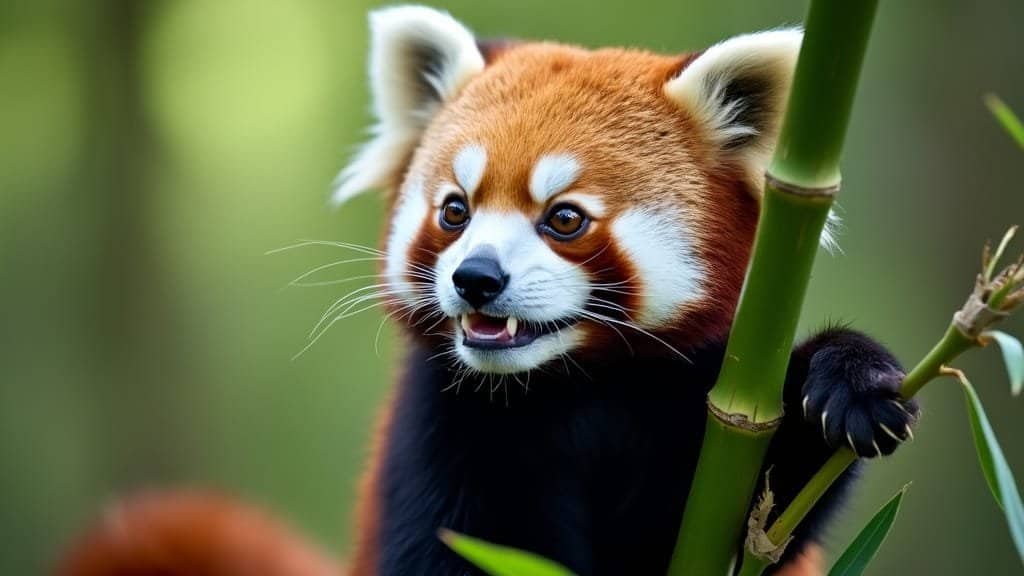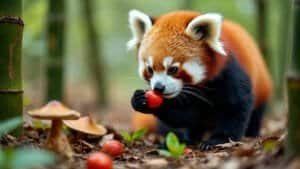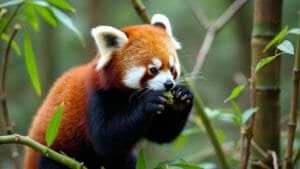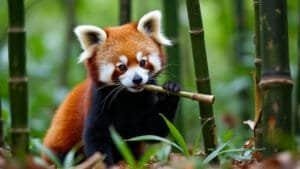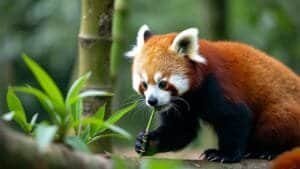The primary diet of the red panda in the wild consists largely of bamboo, which makes up about 85-95% of its total food intake. Despite being classified as a carnivore, the red panda has adapted to a predominantly herbivorous lifestyle, relying on bamboo leaves, tender shoots, and stems for sustenance. However, bamboo alone does not provide all the necessary nutrients, so red pandas occasionally supplement their diet with fruits, flowers, insects, and small amounts of animal protein when available
Because bamboo is low in calories and difficult to digest, red pandas must consume large quantities daily and spend a significant portion of their time foraging. Their specialized adaptations, including strong molars, a pseudo-thumb for grasping bamboo, and a slow metabolism, help them survive on this limited food source. However, their dependence on bamboo makes them vulnerable to habitat loss and seasonal food shortages, impacting their survival in the wild
This article explores the specific dietary habits of red pandas, how their diet changes with the seasons, and the evolutionary adaptations that allow them to process bamboo. We will also examine the impact of food availability on their population and how conservation efforts are working to protect their natural food sources
Bamboo as the Staple of the Red Panda’s Diet
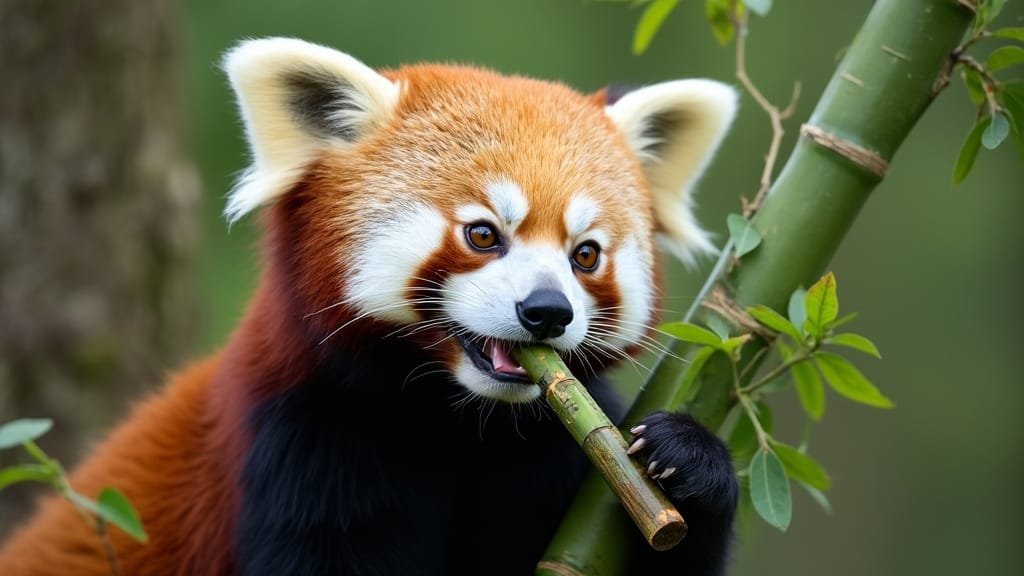
Bamboo is the primary food source for red pandas, making up the majority of their diet year-round. Despite being members of the order Carnivora, red pandas have evolved to rely almost entirely on this fibrous plant. Their digestive system is not specialized for breaking down tough plant material efficiently, which means they must consume large quantities of bamboo every day to meet their energy needs. This heavy reliance on bamboo shapes their foraging behavior, influences their daily activity, and plays a critical role in their survival
How Much Bamboo Do Red Pandas Consume Daily?
Red pandas eat between 2.2 and 4.4 pounds of bamboo per day, an amount necessary to sustain them given bamboo’s low nutritional value. Because bamboo is poor in calories and difficult to digest, red pandas must spend a significant portion of their day feeding. On average, they dedicate up to 13 hours a day to foraging and eating, breaking their feeding into multiple short sessions. Studies have shown that a single red panda can consume as many as 20,000 bamboo leaves per day, reflecting the inefficiency of extracting nutrients from their primary food source
To maximize their energy intake, red pandas exhibit selective feeding behavior, choosing the most nutrient-rich portions of bamboo whenever possible. In spring and summer, when bamboo shoots are abundant, they prioritize consuming these tender, protein-rich parts of the plant. Shoots are easier to digest and contain more water, making them an ideal seasonal food source. As the seasons change and shoots become less available, red pandas shift to eating younger bamboo leaves, which provide some nutritional value but are more fibrous. During the colder months, when food is scarcer, they rely on mature leaves and even bamboo stems, though these parts contain more indigestible fiber and provide fewer essential nutrients
The need for such a high intake of bamboo stems from red pandas’ low-calorie diet and inefficient digestion. Unlike true herbivores, which have specialized stomachs and gut bacteria to break down cellulose, red pandas lack the necessary enzymes to process plant material fully. This limitation means that a large percentage of what they eat passes through their system undigested, requiring them to consume massive amounts of bamboo daily to compensate for the low energy absorption
Why Is Bamboo the Main Food Source for Red Pandas?
Red pandas rely on bamboo primarily because it is a readily available and abundant food source in their natural habitat. The forests of the eastern Himalayas and southwestern China, where they live, are rich in bamboo, allowing them to find food throughout the year without the need for migration. Unlike other food sources such as fruits or insects, which are highly seasonal, bamboo provides a consistent diet, making it a reliable staple for red pandas
However, this specialization comes with challenges. Bamboo forests are susceptible to natural die-offs, where entire areas of bamboo may flower, seed, and then die simultaneously. This natural cycle, which occurs in intervals ranging from 30 to 100 years depending on the species of bamboo, can leave red pandas struggling to find enough food. A study by Yonzon et al. (Biological Conservation, 1987) found that these die-offs have led to temporary declines in red panda populations, forcing them to search for new feeding areas or increase their intake of less-preferred foods
In addition to natural bamboo cycles, habitat destruction poses a significant threat to the red panda’s primary food source. Deforestation and agricultural expansion have led to a decline in bamboo forests, reducing the available feeding grounds for wild red pandas. Conservation efforts now focus on protecting and restoring bamboo-rich forests to ensure red pandas have access to sufficient food year-round
Which Parts of Bamboo Do Red Pandas Prefer?
Although bamboo is their main food source, red pandas do not eat all parts of the plant equally. They show a preference for the most digestible and nutrient-rich portions, selecting tender shoots when available and opting for younger leaves over mature ones whenever possible. The soft, water-filled shoots that emerge in spring and early summer provide the highest levels of protein and hydration, making them the most valuable food source. As these shoots mature and become less abundant, red pandas gradually transition to consuming younger bamboo leaves, which still contain some nutrients but require more effort to chew and digest
During fall and winter, red pandas have fewer dietary options and must rely more on mature bamboo leaves and stems, which contain significantly more fiber. These parts of the plant are tougher, less nutritious, and harder to digest, requiring red pandas to increase their feeding time to compensate for the lower energy intake. To break down the tough plant material, they use their strong molars and powerful jaw muscles, which allow them to grind bamboo into smaller, more manageable pieces
Despite these adaptations, their reliance on bamboo remains a major survival challenge, particularly in areas where bamboo forests are shrinking. Protecting their habitat is essential to ensuring that red pandas continue to have access to the food they need to sustain their populations. For further information on their bamboo consumption and feeding habits, visit the Smithsonian National Zoo’s red panda profile
Additional Foods in the Red Panda’s Diet
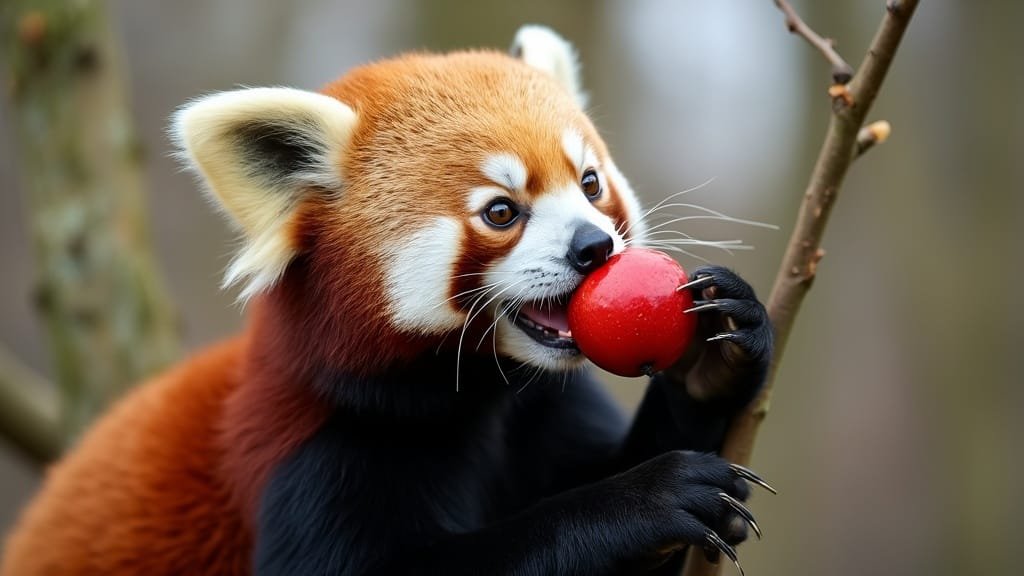
While bamboo makes up the majority of a red panda’s diet, it does not provide all the nutrients necessary for survival. To supplement their nutritional intake, red pandas consume a variety of other foods, including fruits, flowers, insects, and small amounts of animal protein. These additional food sources become particularly important during times when bamboo is less nutritious or less available
Seasonal Variations in Red Panda Feeding Habits
The diet of a red panda changes throughout the year based on the availability of food in its environment. During the spring and summer, when bamboo shoots are abundant and nutrient-rich, red pandas consume them almost exclusively. Shoots provide essential proteins and water content that sustain their energy levels. As the seasons shift and shoots become scarcer, red pandas transition to eating more leaves, which contain higher amounts of fiber but are less nutritious
In the fall, as fruits become more available, red pandas increase their intake of berries, apples, and other wild fruits. Fruits provide natural sugars, vitamins, and hydration, helping red pandas store energy for the colder months ahead. A study by Yonzon et al. (Biological Conservation, 1987) found that red pandas consume more fruits in late summer and fall, likely as a strategy to build fat reserves before winter
During winter, when food is at its scarcest, red pandas rely almost entirely on bamboo leaves, often consuming more than usual to compensate for the lower nutrient levels. They may also eat small amounts of moss, roots, or lichen if bamboo is difficult to find. This seasonal diet shift reflects their ability to adapt to changing environmental conditions while maintaining a primarily plant-based diet
Do Red Pandas Eat Meat or Animal Protein?
Despite being classified within the order Carnivora, red pandas are functionally herbivorous, with bamboo making up 85-95% of their diet. However, they do occasionally consume small amounts of animal protein, particularly in the form of insects, bird eggs, and even small mammals when available. This dietary flexibility helps them obtain additional protein and fats, particularly during seasons when bamboo is less nutritious
Insects, such as caterpillars and grubs, provide a quick source of protein and are commonly eaten when encountered. Bird eggs, while not a staple food, may be consumed opportunistically when found in nests. In rare cases, red pandas have been observed hunting small mammals, though this is uncommon and not a primary food source. Wei et al. (Journal of Mammalogy, 2014) suggested that red pandas’ occasional consumption of animal protein may be an evolutionary holdover from their carnivorous ancestry, even though their diet has since shifted almost entirely to plant material
How Fruits and Insects Supplement Their Nutrition
Fruits and insects play a crucial role in filling the nutritional gaps left by a bamboo-heavy diet. Fruits provide essential vitamins, minerals, and sugars, giving red pandas an energy boost when they are available. The natural sugars found in apples, berries, and wild figs help red pandas replenish energy levels, especially before the harsher winter months. A study by Roberts and Gittleman (Mammalian Biology, 2020) found that red pandas exhibit a strong preference for fruits when given a choice, indicating that these foods serve an important function in their overall diet
Insects contribute protein, fats, and micronutrients that bamboo lacks. While red pandas do not actively hunt insects, they consume them when they come across them while foraging. In captivity, red pandas are often provided with mealworms and other high-protein food items to ensure they receive a well-balanced diet
Although bamboo remains their primary food source, these additional dietary components are essential for maintaining health and survival. The ability to consume a variety of foods, even in small amounts, allows red pandas to adapt to changing environmental conditions and food availability. To learn more about how red pandas adjust their diet throughout the year, visit the WWF page on panda diets
Digestive Adaptations and Survival Strategies

Red pandas have evolved several adaptations to survive on their bamboo-heavy diet. Despite belonging to the order Carnivora, their digestive system functions more like that of herbivorous animals, allowing them to extract nutrients from fibrous plant material. However, because bamboo is low in calories and difficult to digest, red pandas have developed behavioral and physiological strategies to maximize energy intake while conserving energy
How the Red Panda’s Digestive System Processes Bamboo
Red pandas have a short and simple digestive tract, which is more typical of carnivorous mammals than herbivores. Unlike animals such as deer or cows, which have multi-chambered stomachs and specialized gut bacteria to break down cellulose, red pandas lack the enzymes needed to fully digest bamboo. As a result, much of what they eat passes through their system without being completely broken down, making bamboo a relatively inefficient food source for them
To compensate for this, red pandas must eat large amounts of bamboo every day and be highly selective about the parts they consume. They primarily target tender shoots and young leaves, which contain more protein and water than mature stalks. A study by Wei et al. (Journal of Mammalogy, 2014) found that red pandas extract only about 24% of the available energy from bamboo, meaning they must consume food frequently and in large quantities to meet their energy needs. This low digestive efficiency is why red pandas spend up to 13 hours per day eating and rest for long periods to conserve energy
Physical Adaptations for Eating and Grasping Bamboo
Red pandas have developed several physical adaptations that help them process and consume bamboo more efficiently. One of their most distinctive features is their modified wrist bone, often referred to as a “pseudo-thumb.” This extra digit functions like a thumb, allowing red pandas to grip and manipulate bamboo stalks with precision. This adaptation is similar to that of the giant panda, although the two species are not closely related
Their teeth and jaw structure have also evolved to handle a plant-based diet. Red pandas have strong molars and well-developed jaw muscles, which allow them to chew tough bamboo leaves and stems effectively. Their broad, flat premolars are particularly useful for crushing fibrous plant material, breaking it down before digestion. These dental adaptations are essential for processing large amounts of bamboo each day
Another adaptation that helps red pandas manage their bamboo diet is their low metabolic rate. Since bamboo provides limited energy, red pandas conserve energy by reducing activity levels and limiting unnecessary movement. During colder months, they further lower their metabolism to survive on even fewer calories. This strategy allows them to survive on a diet that would not be sufficient for most other carnivorous mammals
Differences Between Wild and Captive Red Panda Diets
The diet of red pandas in captivity differs from that of their wild counterparts in several ways. While wild red pandas rely almost entirely on bamboo and seasonal fruits, those in zoos and conservation centers receive a more varied and nutritionally balanced diet to ensure they remain healthy. Captive red pandas are often fed high-quality bamboo, fruits such as apples and bananas, specially formulated biscuits for herbivores, and sometimes protein sources like eggs or mealworms. These foods help provide a balanced mix of vitamins and minerals that bamboo alone may not supply
A study by Roberts and Gittleman (Mammalian Biology, 2020) found that captive red pandas tend to maintain a more stable weight and higher body condition than their wild counterparts due to the consistency and quality of their diet. However, because their digestive system is still optimized for bamboo, sudden dietary changes can cause digestive issues. Zoos carefully monitor red pandas’ diets and adjust them gradually to prevent health complications
Although captive red pandas receive better nutrition, their diet must still mimic their natural eating habits as closely as possible. Providing access to fresh bamboo remains a priority in conservation programs, as it helps maintain their natural foraging behaviors and digestive health. For more information on red panda dietary adaptations, visit the Study.com article on red panda feeding habits
